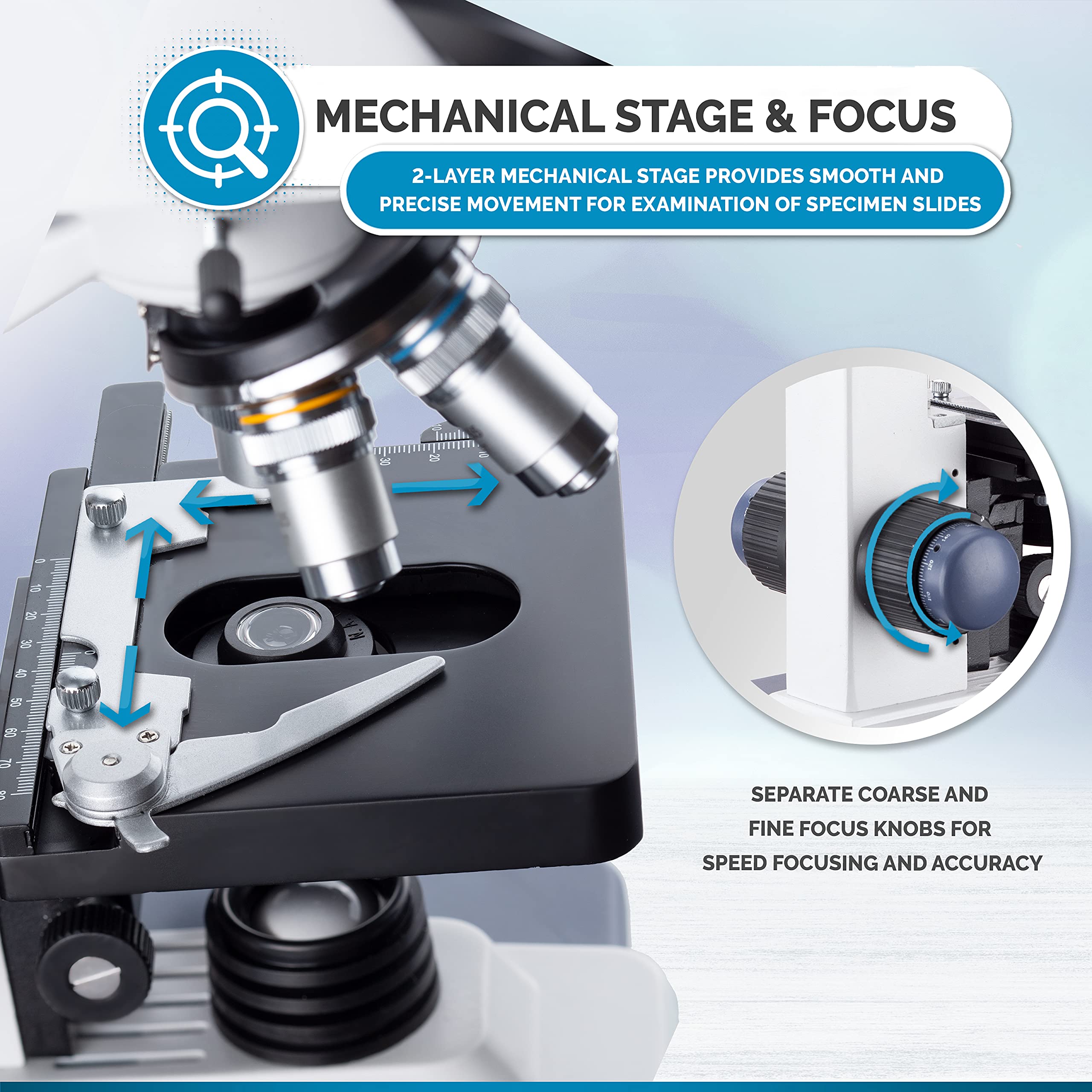All Categories








AmScope B120C Series Student & Professional LED Binocular Compound Microscope - 40X-2500X Magnification - Features Siedentopf Head & 3D Mechanical Stage
Share Tweet
Get it between 2024-12-04 to 2024-12-11. Additional 3 business days for provincial shipping.
*Price and Stocks may change without prior notice
*Packaging of actual item may differ from photo shown
- Electrical items MAY be 110 volts.
- 7 Day Return Policy
- All products are genuine and original








AmScope B120C Series Student & Professional LED Features
-
Magnification Excellence: The AmScope B120 compound microscope offers a broad magnification range from 40X to 2500X, enabling detailed examination of microscopic specimens
-
Advanced LED Illumination: Equipped with energy-efficient LED light, this binocular microscope provides bright, daylight-balanced illumination with a specialized fly-eye lens
-
Ergonomic Design: The microscope features a 360-degree rotatable Siedentopf head with adjustable interpupillary distance for comfortable and flexible viewing
-
Precision Stage Control: A 3D mechanical stage and coaxial coarse and fine focus knobs allow for smooth and precise adjustments
-
About AmScope: We have the industry's leading collection of microscopes, microscopes cameras, accessories and other related products
About AmScope B120C Series Student & Professional LED
The AmScope B120C compound binocular microscope has pairs of 10x widefield and 25x widefield eyepieces, a forward-facing nosepiece with four DIN achromatic objectives, Brightfield (BF) LED illumination, a 1.25 NA Abbe condenser, and a double-layer mechanical stage.The Siedentopf binocular head has interchangeable pairs of 10x widefield and 25x widefield eyepieces with 53 to 77mm Siedentopf inter-pupillary adjustment, a fixed 30-degree vertical inclination to reduce eye and neck strain, and a 360-degree rotation capability to provide a more comprehensive view and enable sharing. Dioptric adjustment accommodates individual eye-strength differences. The forward-facing nosepiece has 4x, 10x, 40xS (spring), and 100xS (spring, oil) DIN achromatic objectives that combine with the eyepieces to provide color correction of magnified images at five magnifications. The 40xS objective is spring loaded to prevent slide damage when focusing. The 100xS spring-loaded oil objective provides increased resolution over a standard objective. A compound microscope is used for inspection and dissection of specimens when two-dimensional images are desired. The microscope has lower (diascopic) Brightfield illumination that transmits light up through the specimen for enhanced visibility of translucent and transparent objects. Brightfield (BF) illumination allows the specimen to absorb light, resulting in a dark image on a light background. LED illumination provides bright, cool light for working with temperature-sensitive or live specimens. The 1.25 NA Abbe condenser can be adjusted to control the distance of the light from the stage and has an iris diaphragm to optimize the amount of light illuminating the specimen. The double-layer mechanical stage, with 1mm stage divisions, locks the slide into place and provides precise slide manipulation along the X- and Y-axis to allow coordinates to be recorded, enabling the viewer to return to a specific location on the slide. Separate coarse and fine focus knobs speed focusing. The enamel-coated cast-steel body is durable and resistant to stains and corrosion. SpecificationsHeadCompound binocularEyepiecesWF 10x, WF 25xObjectives4X, 10x, 40xS, 100xS (oil)StageDouble-layer MechanicalLighting configurationTransmitted (bottom)Condenser1.25 NA AbbeDiaphragmIrisLight sourceLEDIllumination typeBrightfieldPower100 to 240VAC 50/60Hz Microscopes are instruments used to enhance the resolution of an object or image. Types include compound, stereo, or digital. Compound microscopes use a compound optical system with an objective lens and an eyepiece. Stereo microscopes show object depth in a three-dimensional image. Digital microscopes are used to display an image on a monitor, rather than looking through a lens. Microscopes can have monocular (one), binocular (two), or trinocular (three) eyepieces, with varying magnification abilities. Magnification ability refers to the size of an image. Resolution, also known as resolvant power, refers to the clarity of the image. The interaction between field of view (FOV), numerical aperture (NA), and working distance (WD) determines resolution. Microscopes can control magnification through a fixed focus, or through a range of adjustments. They can also utilize LED, fluorescent, and mirror light sources to help control viewing capabilities. Microscopes are widely used in education, lab research, biology, metallurgy, engineering, chemistry, manufacturing, and in the medical, forensic science, and veterinary industries. United Scope manufactures microscopy equipment and accessories under the brand name AmScope. The company, founded in 1996, is headquartered in Irvine, CA. What's in the Box? AmScope B120C microscope with double-layer mechanical stage (4) DIN Standard Objectives; 4x, 10x, 40xS, and 100xS (oil) 10x widefield eyepieces, one pair 25x widefield eyepieces, one pair Color filter, blue Immersion oil, one bottle Dust cover Instructions





















